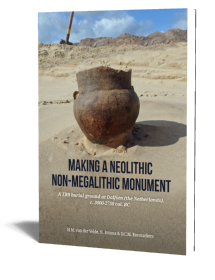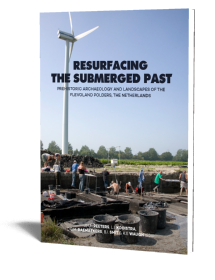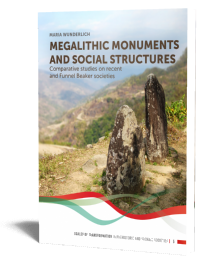Changing Identity in a Changing World
Current Studies on the Stone Age around 4000 BCE
Edited by Daniel Groß and Mikael Rothstein | 2023

Changing Identity in a Changing World
Current Studies on the Stone Age around 4000 BCE
Edited by Daniel Groß and Mikael Rothstein | 2023
Paperback ISBN: 9789464261677 | Hardback ISBN: 9789464261684 | Imprint: Sidestone Press | Format: 173x253mm | 314 pp. | Language: English | 27 illus. (bw) | 64 illus. (fc) | Keywords: archaeology; neolithisation; organic artefacts; culture contact; subsistence; material culture; cultural identity | download cover | DOI: 10.59641/pfm7c6gh
Read online or downloaded 1803 times
-
Digital & Online access
This is a full Open Access publication, click below to buy in print, browse, or download for free.
-
Buy via Sidestone (EU & UK)
-
Buy via our Distributors (WORLD)
For non-EU or UK destinations you can buy our books via our international distributors. Although prices may vary this will ensure speedy delivery and reduction in shipping costs or import tax. But you can also order with us directly via the module above.
UK international distributor
USA international distributor
-
Bookinfo
Paperback ISBN: 9789464261677 | Hardback ISBN: 9789464261684 | Imprint: Sidestone Press | Format: 173x253mm | 314 pp. | Language: English | 27 illus. (bw) | 64 illus. (fc) | Keywords: archaeology; neolithisation; organic artefacts; culture contact; subsistence; material culture; cultural identity | download cover | DOI: 10.59641/pfm7c6gh
Read online or downloaded 1803 times

We will plant a tree for each order containing a paperback or hardback book via OneTreePlanted.org.
From 2013-2022 the largest Stone Age excavation ever undertaken in Denmark, uncovered an entire fjord landscape beneath marine sediments at Rødbyhavn on the island of Lolland. Based on the excavations, Museum Lolland-Falster, in collaboration with Aarhus University and the Danish National Museum, organised an international conference on the topic of “LOST 2022 – Changing Identity in a Changing World” on 16 and 17 June 2022 to discuss the time around 4000 BCE in Denmark and beyond from different angles.
This book summarizes the conference and presents its main outcomes. It also gives an overview of the current state of research within the Femern project and sets them into context with the wider area. By including contributions from the Netherlands to Finland, the central position of Lolland as a corridor in the Stone Age is highlighted and discussed. The topics covered in this book deal with technological change, archaeological analyses of identity, aspects of landscape interaction and perception in the Late Mesolithic and Early Neolithic.
This book is aimed at specialists, students and the interested public alike, as it provides the first complete overview of the excavations of the Femern project and places them in context. At the same time, it serves as a basis for further studies on the material and highlights the challenges and possibilities of the archaeological record from the period around 4000 BCE.
Forword
Ulla Schaltz and Kasper Høhling Søsted
Introduction: Changing Identity in a Changing World
Daniel Groß and Mikael Rothstein
PART 1: Changing worlds
The Femern project: a large-scale excavation of a Stone Age landscape
Bjørnar Måge, Daniel Groß and Marie Kanstrup
Environmental changes after the last deglaciation, southern Lolland, Denmark
Ole Bennike and Catherine Jessen
Niche construction: Hard-working settlers and a neglected principle in understanding the early Neolithic of southern Scandinavia
Niels Nørkjær Johannsen
Estuary and lacustrine fishing with stationary wooden structures in Neolithic Finland: Evidence from waterlogged sites
Satu Koivisto
How to build a Neolithic? Perspectives on megalith building practices and landscape perception during the Funnel Beaker period in northern Germany
Maria Wunderlich
Tombs and Settlements, Bog and Sea – the possible influence of landscape change on Neolithic life in the Ahlen-Falkenberger Moor, Germany
Moritz Mennenga, Anja Behrens, Martina Karle and Steffen Wolters
PART 2: Losing Boundaries
Duality in the Early Neolithic on Lolland-Falster and in south Scandinavia
Theis Zetner Trolle Jensen and Lasse Sørensen
Long-term perspectives on Neolithisation: Pottery use in the Ertebølle Culture and its connection to the development of settlement patterns and hunter-gatherer complexity
Ann-Katrin Meyer
Changing diet in a changing world
Bente Philippsen
Mesolithic persistence and Neolithic emergence at Syltholm II (MLF00906-III). Osseous artefacts before and after 4000 BCE on the coast of Lolland, Denmark
Solveig Chaudesaigues-Clausen
Neolithisation in Denmark from a depositional perspective
Søren Anker Sørensen
Lola’s people hunted wild boar; their neighbours kept domestic pigs: analysis of the Syltholm pigs
Peter Rowley-Conwey
Neolithic farming in forager-resource systems: A case from southern Norway
Svein Vatsvåg Nielsen and Jo-Simon Frøshaug Stokke
PART 3: Identities of Change
Mesolithic hunters in mixed oak forests: Differences in hunting strategy and hunting behaviour
Ulrich Schmölcke
Changing diet during the Mesolithic-Neolithic transition: An examination of the carbon and nitrogen isotope ratios of late Mesolithic and early Neolithic humans in Denmark
Rikke Maring, Jesper Olsen and Marcello A. Mannino
Going against the grain? The transition to farming in the Dutch wetlands re-examined (5000–4000 BCE)
Daan C. M. Raemaekers, Nathalie Ø. Brusgaard, Merita Dreshaj, Jolijn Erven, Michael W. Dee and J. Hans M. Peeters
Stone Age Fishing in the prehistoric Syltholm Fjord
Terje Stafseth and Daniel Groß
The Unbeknownst Pottery Craft at the Alvastra Pile Dwelling
Nathalie Hinders
Evidence of a base model for Neolithic depositions in Central and Northern Europe
Michael Müller
People, contacts and identities: the sixth-fifth millennium south of the western Baltic Sea
Thomas Terberger, Andreas Kotula and Henny Piezonka
Perceptions of Stone Age Landscapes? A note on how humans of the Stone Age may have experienced their surroundings
Mikael Rothstein

Dr. Daniel Groß
Daniel Groß is curator and research coordinator at Museum Lolland-Falster. His main field of work are wetland archaeology and Stone Age archaeology with a particular interest in human-environment interactions. In his projects he deals with artefact studies, landscape and settlement archaeology and socio-economic change through bridging humanistic and natural scientific approaches.
Daniel studied Pre- and Protohistoric Archaeology at the University of Hamburg and was awarded a PhD at Kiel University in 2014. He worked at the Centre for Baltic and Scandinavian Archaeology and in the Collaborative Research Centre 1266 “Scales of Transformation” in Germany before moving to Museum Lolland-Falster, Denmark, in 2021.

Dr. Mikael Rothstein
Mikael Rothstein is Associate Professor of comparative religion at the University of Southern Denmark. He also holds the title of Visiting Professor at the Vytautas Magnus University in Kaunas, Lithuania and Research Professor at Museum Lolland-Falster. His research primarily deals with issues of new religions, religion in the Hellenistic-Roman ages, religion among hunter-gatherers and other indigenous peoples, and religion in the Mesolithic and Neolithic.
Mikael studied comparative religion at the university of Copenhagen, where he also finished his PhD in 1993. After many years as tenured there, he became Associate Professor at University of Southern Denmark in 2013.
Abstract:
From 2013-2022 the largest Stone Age excavation ever undertaken in Denmark, uncovered an entire fjord landscape beneath marine sediments at Rødbyhavn on the island of Lolland. Based on the excavations, Museum Lolland-Falster, in collaboration with Aarhus University and the Danish National Museum, organised an international conference on the topic of “LOST 2022 – Changing Identity in a Changing World” on 16 and 17 June 2022 to discuss the time around 4000 BCE in Denmark and beyond from different angles.
This book summarizes the conference and presents its main outcomes. It also gives an overview of the current state of research within the Femern project and sets them into context with the wider area. By including contributions from the Netherlands to Finland, the central position of Lolland as a corridor in the Stone Age is highlighted and discussed. The topics covered in this book deal with technological change, archaeological analyses of identity, aspects of landscape interaction and perception in the Late Mesolithic and Early Neolithic.
This book is aimed at specialists, students and the interested public alike, as it provides the first complete overview of the excavations of the Femern project and places them in context. At the same time, it serves as a basis for further studies on the material and highlights the challenges and possibilities of the archaeological record from the period around 4000 BCE.
Contents
Forword
Ulla Schaltz and Kasper Høhling Søsted
Introduction: Changing Identity in a Changing World
Daniel Groß and Mikael Rothstein
PART 1: Changing worlds
The Femern project: a large-scale excavation of a Stone Age landscape
Bjørnar Måge, Daniel Groß and Marie Kanstrup
Environmental changes after the last deglaciation, southern Lolland, Denmark
Ole Bennike and Catherine Jessen
Niche construction: Hard-working settlers and a neglected principle in understanding the early Neolithic of southern Scandinavia
Niels Nørkjær Johannsen
Estuary and lacustrine fishing with stationary wooden structures in Neolithic Finland: Evidence from waterlogged sites
Satu Koivisto
How to build a Neolithic? Perspectives on megalith building practices and landscape perception during the Funnel Beaker period in northern Germany
Maria Wunderlich
Tombs and Settlements, Bog and Sea – the possible influence of landscape change on Neolithic life in the Ahlen-Falkenberger Moor, Germany
Moritz Mennenga, Anja Behrens, Martina Karle and Steffen Wolters
PART 2: Losing Boundaries
Duality in the Early Neolithic on Lolland-Falster and in south Scandinavia
Theis Zetner Trolle Jensen and Lasse Sørensen
Long-term perspectives on Neolithisation: Pottery use in the Ertebølle Culture and its connection to the development of settlement patterns and hunter-gatherer complexity
Ann-Katrin Meyer
Changing diet in a changing world
Bente Philippsen
Mesolithic persistence and Neolithic emergence at Syltholm II (MLF00906-III). Osseous artefacts before and after 4000 BCE on the coast of Lolland, Denmark
Solveig Chaudesaigues-Clausen
Neolithisation in Denmark from a depositional perspective
Søren Anker Sørensen
Lola’s people hunted wild boar; their neighbours kept domestic pigs: analysis of the Syltholm pigs
Peter Rowley-Conwey
Neolithic farming in forager-resource systems: A case from southern Norway
Svein Vatsvåg Nielsen and Jo-Simon Frøshaug Stokke
PART 3: Identities of Change
Mesolithic hunters in mixed oak forests: Differences in hunting strategy and hunting behaviour
Ulrich Schmölcke
Changing diet during the Mesolithic-Neolithic transition: An examination of the carbon and nitrogen isotope ratios of late Mesolithic and early Neolithic humans in Denmark
Rikke Maring, Jesper Olsen and Marcello A. Mannino
Going against the grain? The transition to farming in the Dutch wetlands re-examined (5000–4000 BCE)
Daan C. M. Raemaekers, Nathalie Ø. Brusgaard, Merita Dreshaj, Jolijn Erven, Michael W. Dee and J. Hans M. Peeters
Stone Age Fishing in the prehistoric Syltholm Fjord
Terje Stafseth and Daniel Groß
The Unbeknownst Pottery Craft at the Alvastra Pile Dwelling
Nathalie Hinders
Evidence of a base model for Neolithic depositions in Central and Northern Europe
Michael Müller
People, contacts and identities: the sixth-fifth millennium south of the western Baltic Sea
Thomas Terberger, Andreas Kotula and Henny Piezonka
Perceptions of Stone Age Landscapes? A note on how humans of the Stone Age may have experienced their surroundings
Mikael Rothstein

Dr. Daniel Groß
Daniel Groß is curator and research coordinator at Museum Lolland-Falster. His main field of work are wetland archaeology and Stone Age archaeology with a particular interest in human-environment interactions. In his projects he deals with artefact studies, landscape and settlement archaeology and socio-economic change through bridging humanistic and natural scientific approaches.
Daniel studied Pre- and Protohistoric Archaeology at the University of Hamburg and was awarded a PhD at Kiel University in 2014. He worked at the Centre for Baltic and Scandinavian Archaeology and in the Collaborative Research Centre 1266 “Scales of Transformation” in Germany before moving to Museum Lolland-Falster, Denmark, in 2021.

Dr. Mikael Rothstein
Mikael Rothstein is Associate Professor of comparative religion at the University of Southern Denmark. He also holds the title of Visiting Professor at the Vytautas Magnus University in Kaunas, Lithuania and Research Professor at Museum Lolland-Falster. His research primarily deals with issues of new religions, religion in the Hellenistic-Roman ages, religion among hunter-gatherers and other indigenous peoples, and religion in the Mesolithic and Neolithic.
Mikael studied comparative religion at the university of Copenhagen, where he also finished his PhD in 1993. After many years as tenured there, he became Associate Professor at University of Southern Denmark in 2013.
-
Digital & Online access
This is a full Open Access publication, click below to buy in print, browse, or download for free.
-
Buy via Sidestone (EU & UK)
-
Buy via our Distributors (WORLD)
For non-EU or UK destinations you can buy our books via our international distributors. Although prices may vary this will ensure speedy delivery and reduction in shipping costs or import tax. But you can also order with us directly via the module above.
UK international distributor
USA international distributor
- Browse all books by subject
-
Search all books

We will plant a tree for each order containing a paperback or hardback book via OneTreePlanted.org.
You might also like:
© 2025 Sidestone Press KvK nr. 28114891 Privacy policy Sidestone Newsletter Terms and Conditions (Dutch)








